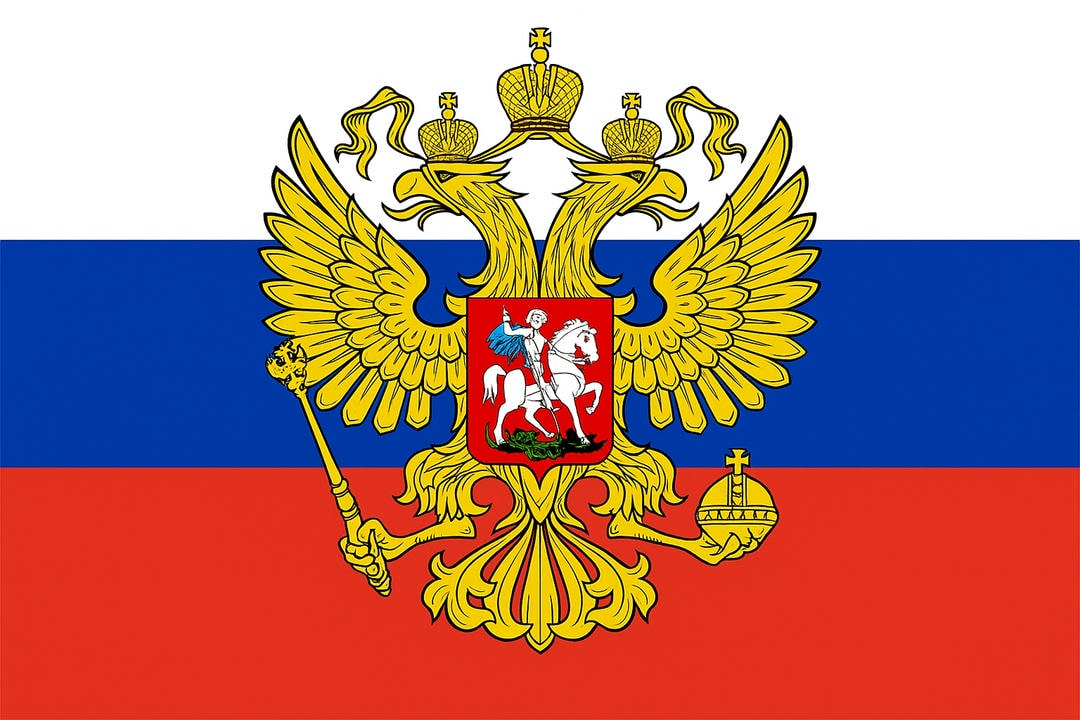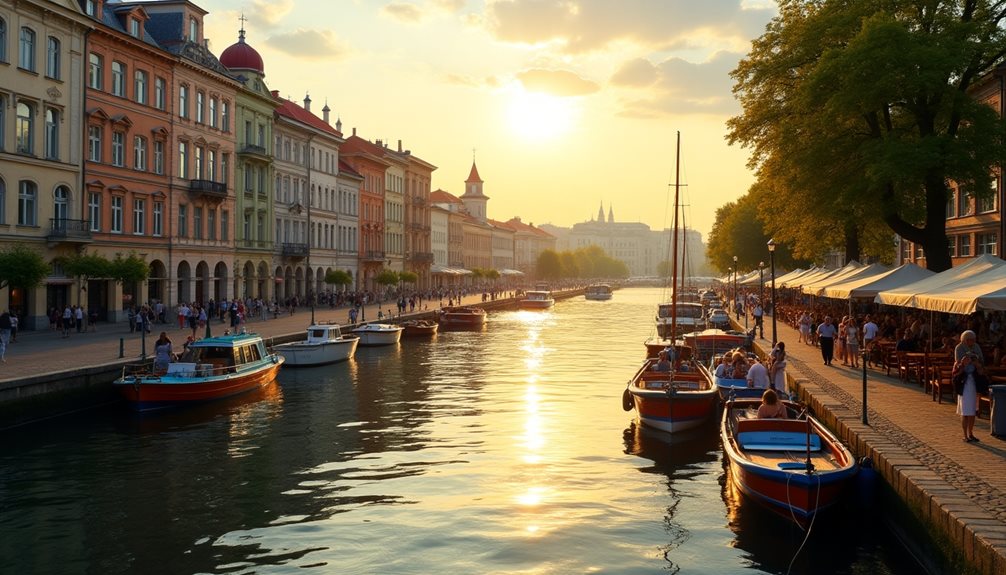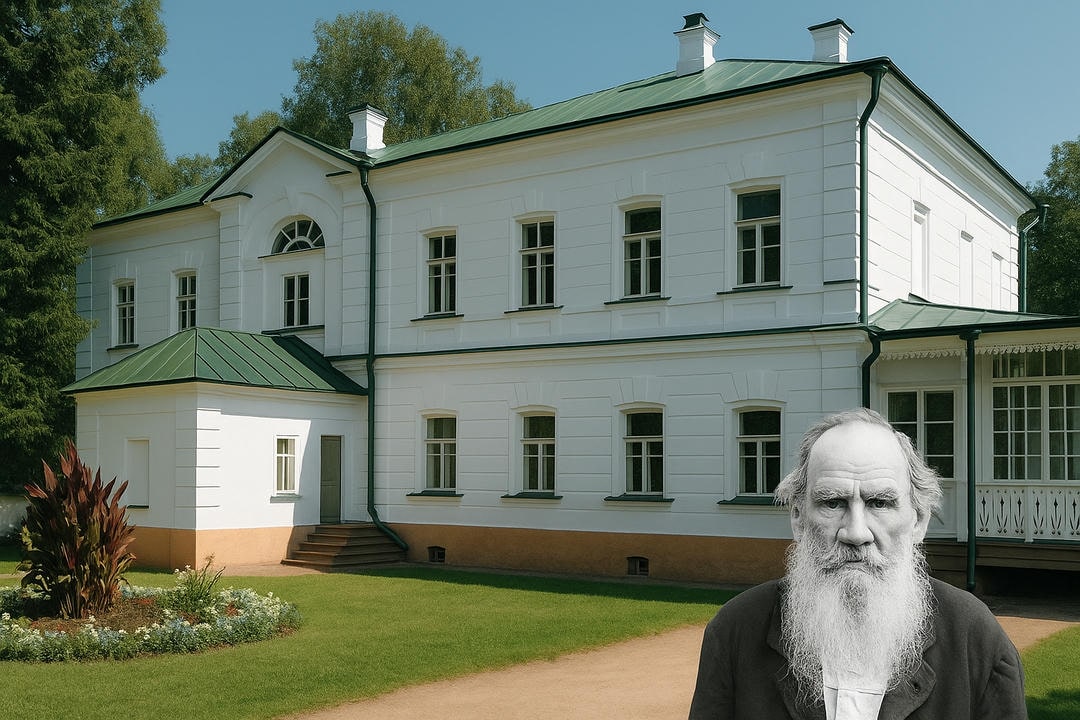Exploring Russia’s capitals reveals intricate layers of its historical narrative. Each city, from the early settlements of Old Ladoga to the grandeur of Saint Petersburg, serves as a reflection of the nation’s evolving identity. The shift of power among these capitals highlights shifts in governance and cultural influence. Understanding these shifts raises questions about how past events have shaped contemporary Russia and what they signify for its future trajectory.
Introduction
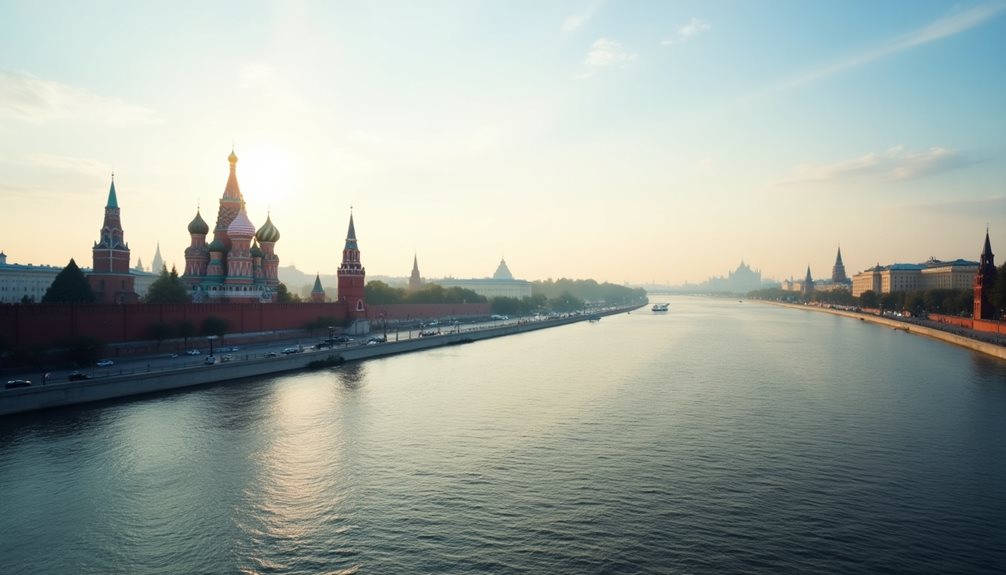
Russia’s history is characterized by a dynamic interplay of cultural and political developments, with its capitals serving as pivotal points in this evolution. Each capital represents a distinct phase of governance and societal change, contributing to the depth and complexity of Russian identity.
Understanding these capitals is crucial for grasping the broader narrative of Russia’s diverse culture and historical trajectory. The nation’s history, often viewed through a contemporary lens, reveals a complex narrative marked by significant cultural and political milestones.
Russia’s cultural landscape is shaped by centuries of ethnic influences, reflected in historical artifacts and folklore traditions that provide insight into the beliefs and values of its people. The architectural styles, ranging from Byzantine to Baroque, embody the fusion of influences that have defined the nation. Together, these elements illustrate a society deeply connected to its multifaceted heritage and evolving identity.
The Ancient Capitals of Russia
Russia’s ancient capitals, including Old Ladoga, Novgorod, and Kiev, mark key milestones in the nation’s early development. Each city played a unique role in shaping governance, trade, and cultural identity during pivotal moments in history.
Old Ladoga: Birthplace of Russian Statehood
Old Ladoga is recognized as the starting point of Russian statehood. It was here that Rurik, the Varangian leader, arrived in 862 to establish governance among the Slavic tribes. This early capital served as a vital hub on the Varangian trade route, connecting Northern Europe to Byzantium. Artifacts from the region highlight its importance in fostering early societal structures and blending Norse and Slavic traditions.
Novgorod: A Center of Trade and Administration
Novgorod emerged as a significant center for trade and governance under Rurik and his successor Oleg. The city’s strategic location on trade routes facilitated cultural exchange and economic growth. Its medieval architecture, including fortifications and churches, reflects its prosperity during this era. Novgorod laid the groundwork for administrative systems that influenced the development of the Russian state.
Kiev: Heart of Kievan Rus
Kiev became the political and religious center of Kievan Rus under Prince Oleg in 882. As a capital, it unified powerful regional centers and established trade networks that connected Byzantium with Eastern Europe. The spread of Christianity under Prince Vladimir further solidified Kiev’s role as a spiritual stronghold, shaping societal norms and fostering unity among diverse tribes.
These ancient capitals offer a glimpse into Russia’s formative years, showcasing their enduring influence on the nation’s cultural and political identity.
Transition to Northern Powerhouses
The shift in power to northern cities in Russia marked a pivotal moment in the nation’s political landscape. As Kiev’s influence waned, particularly during the Mongol invasions, Vladimir rose to prominence. This period laid the groundwork for Moscow’s ascent from a modest settlement to the capital under Ivan the Terrible, establishing it as a central authority in the region.
Vladimir: A Northern Powerhouse
Vladimir’s rise was facilitated by its strategic location, which allowed it to become a hub for trade and governance. Amidst the Mongol invasions, local leaders adopted innovative strategies, enhancing Vladimir’s historical significance. The city’s architecture, featuring distinctive churches and fortifications, reflected its growing power and aspirations. Vladimir emerged as a crucial northern powerhouse, shaping Russian history during this tumultuous period.
Moscow: From Settlement to Capital
Moscow’s transformation under Ivan the Terrible represents a significant chapter in Russia’s narrative. This period saw a shift in architecture, reflecting Ivan’s reforms that centralized power and promoted cultural evolution. The grand construction of the Kremlin symbolized Moscow’s emerging dominance, solidifying its status as the heart of a unified Russia. Urban legends surrounding Ivan’s reign highlight the complexities of his legacy, further cementing Moscow’s position as a central political and cultural powerhouse.
Saint Petersburg: The Imperial Capital
Established by Peter the Great in the early 18th century, Saint Petersburg was envisioned as a European-style capital reflecting Russia’s aspirations for modernization and cultural alignment with the West. This city played a vital role in shaping Russia’s political and social landscape until the Bolshevik Revolution in 1917. Its architectural grandeur and strategic significance underscore its lasting impact on Russia’s identity and development during a transformative era.
Peter the Great’s vision for Saint Petersburg extended beyond geography; it embodied a fundamental shift in Russia’s cultural identity. Through his reforms, the city became a hub for architectural innovations, showcasing Western influences in its grand structures. This new capital served as a pivotal hub for cultural integration, aligning Russia with European norms. The emphasis on naval expansion underscored Peter’s ambition for a formidable maritime presence, reshaping Russia’s role on the global stage and fostering a new era of enlightenment and progress.
Saint Petersburg’s historical significance lies in fostering political evolution as the seat of Russian governance. Culturally, it embodied Western influences, shaping a new Russian identity. Architectural styles reflected this transformation, with baroque and neoclassical designs symbolizing imperial aspirations. Economic developments flourished through trade and industry, positioning Saint Petersburg as an essential commercial hub. Collectively, these factors solidified its role in molding modern Russia’s trajectory, ultimately paving the way for revolutionary change.
Cultural Highlights Along the Way
Russia’s landscape is punctuated by iconic landmarks that reflect its historical and cultural evolution, with the Novgorod Kremlin, Moscow Kremlin, and St. Petersburg’s Church of the Savior on Spilled Blood serving as prime examples.
Each structure showcases distinctive Kremlin architecture, embodying cultural symbolism and historical significance. The Novgorod Kremlin represents the roots of Russian governance, while the Moscow Kremlin stands as a representation of the centralized power that shaped modern Russia.
St. Petersburg’s Church epitomizes the artistic aspirations of an imperial era. These landmarks not only enhance tourist experiences but also highlight the importance of landmark preservation in safeguarding national heritage.
Trade Routes and Architecture
Trade routes have historically played a significant role in shaping not only the economic landscape but also the architectural styles and cultural exchanges across regions.
In Russia, the convergence of trade routes facilitated interactions among diverse merchant communities, leading to a rich mosaic of cultural exchange.
Architectural styles in cities like Novgorod and Moscow reflect influences from Byzantine, Mongol, and Western European designs, showcasing the historical influence of these interactions.
As goods and ideas traversed these routes, they enriched local customs and practices, ultimately contributing to a distinct Russian identity that celebrates both its heritage and the diverse influences that shaped it.
Practical Tips for Visitors
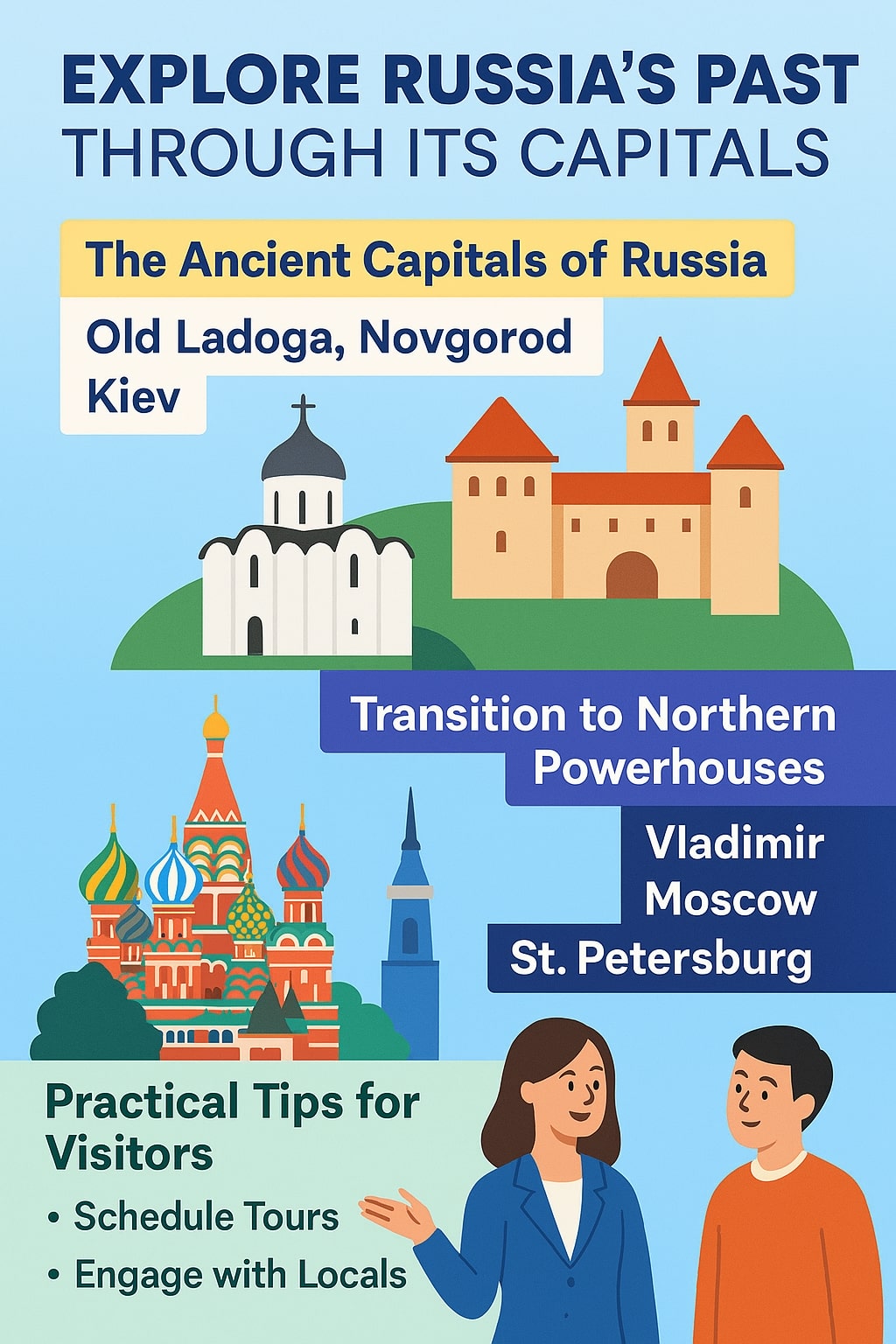
In exploring Russia’s historical cities, visitors benefit from suggested itineraries that highlight key landmarks and cultural experiences.
Additionally, understanding how to navigate language barriers can enhance interactions with locals, fostering a more enriching travel experience.
Suggested itineraries for exploring historical cities
How can travelers effectively navigate the rich fabric of Russia’s historical capitals? Suggested itineraries should encompass diverse historical itineraries that highlight architectural tours in cities like Moscow and Saint Petersburg.
Cultural experiences, such as visiting museums and theaters, provide insight into Russia’s artistic heritage. Travelers should indulge in local cuisines, sampling traditional dishes in each city.
Additionally, interactive workshops on crafts or cooking enhance engagement with local culture. By combining these elements, visitors can create enriching experiences that honor the legacy of Russia’s capitals, fostering a deeper understanding of the nation’s complex history and vibrant present.
Navigating language barriers and engaging with locals
Exploring Russia’s historical capitals offers travelers a unique opportunity to engage with a rich cultural mosaic, but effective communication can present challenges due to language barriers.
To enhance cultural immersion, visitors may consider participating in language exchange programs, fostering connections with locals. Familiarity with local customs is essential; simple gestures and phrases can bridge gaps.
Practical communication tips, such as using translation apps or carrying phrasebooks, can ease interactions. Overcoming challenges in communication not only enriches the travel experience but also promotes understanding and appreciation of Russia’s diverse heritage, ultimately deepening the connection between visitors and the local populace.
Conclusion
While traversing through Russia’s historical capitals, one can uncover a profound understanding of the nation’s cultural heritage and identity.
Each city, from Old Ladoga to Saint Petersburg, offers unique narratives that reflect the evolution of Russian society and governance. Visitors engage in cultural immersion, exploring museums, churches, and monuments that tell stories of resilience and creativity.
This experiential learning fosters a deeper appreciation of Russia’s multifaceted narrative, bridging the gap between past and present. By visiting these capitals, individuals not only witness the grandeur of Russian history but also gain insight into the enduring values that shape its cultural landscape today.

